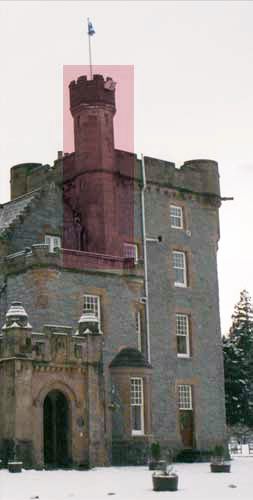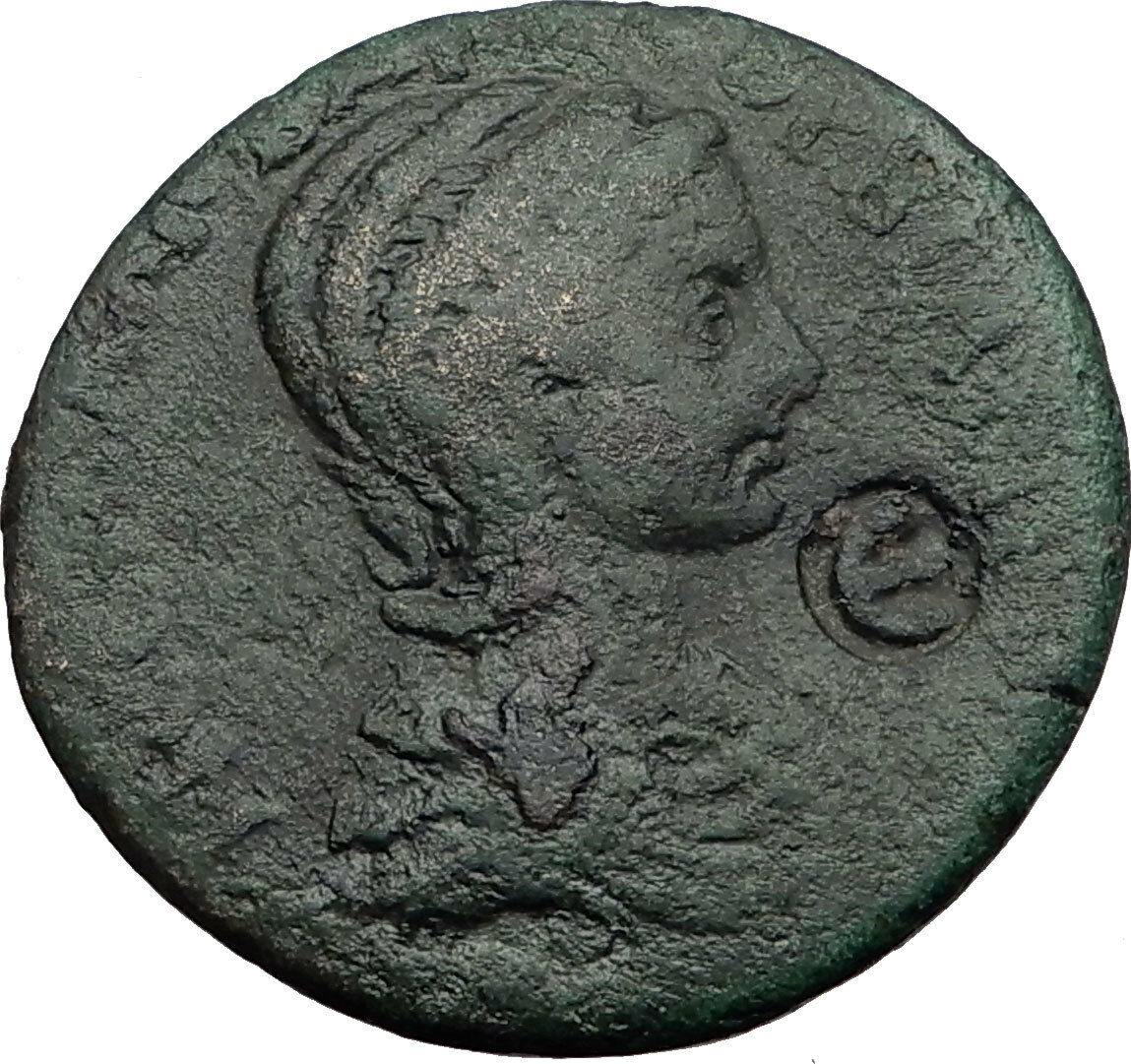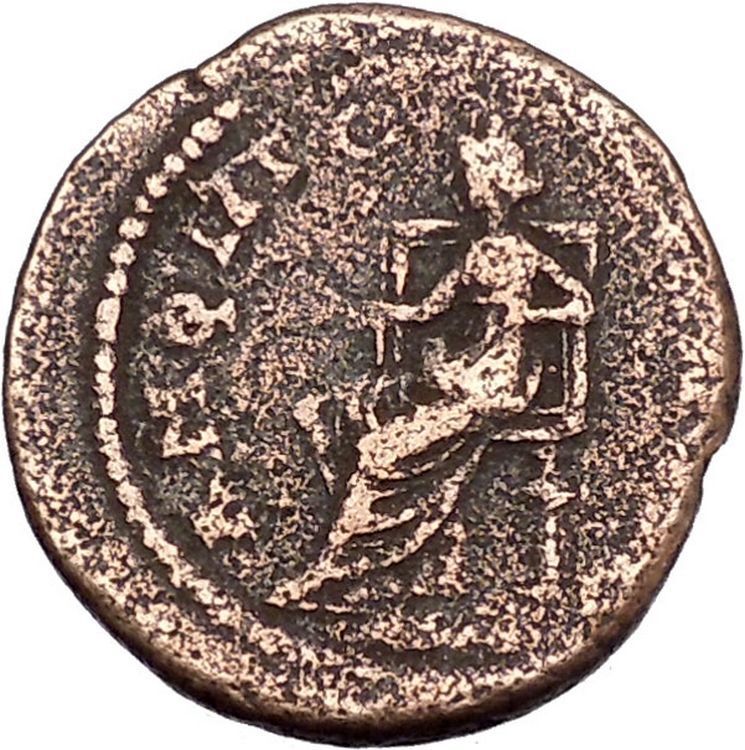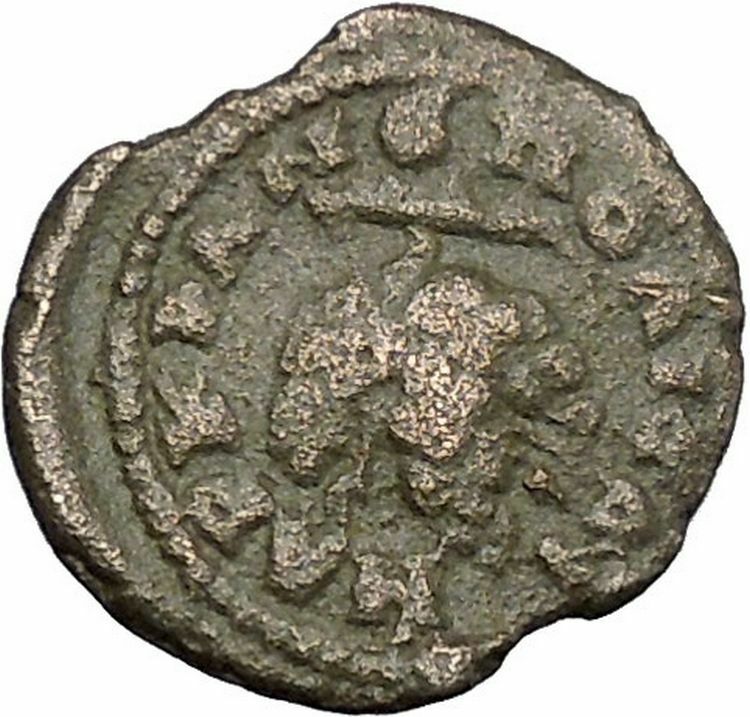|
Septimius Severus
–
Roman Emperor
: 193-211 A.D. –
Bronze 22mm (2.96 grams) of Philippopolis in Thrace
Laureate head right.
Turreted draped bust of Tyche right.
You are bidding on the exact item pictured,
provided with a Certificate of Authenticity and Lifetime Guarantee of
Authenticity.
Tyche (Greek for luck; the Roman equivalent was
Fortuna
) was the presiding
tutelary deity
that governed the fortune and
prosperity of a city, its destiny. Increasingly during the Hellenistic period,
cities had their own specific iconic version of Tyche, wearing a
mural crown
(a crown like the walls of the
city).

The
Greek historian Polybius
believed that when no cause can be
discovered to events such as floods, droughts, frosts or even in politics, then
the cause of these events may be fairly attributed to Tyche.
Stylianos Spyridakis concisely expressed Tyche’s appeal in a Hellenistic
world of arbitrary violence and unmeaning reverses: “In the turbulent years of
the Epigoni of Alexander
, an awareness of the
instability of human affairs led people to believe that Tyche, the blind
mistress of Fortune, governed mankind with an inconstancy which explained the
vicissitudes of the time.”
In literature, she might be given various genealogies, as a daughter of
Hermes
and
Aphrodite
, or considered as one of the
Oceanids
, daughters of
Oceanus
and
Tethys
, or of
Zeus. She was connected with
Nemesis
and
Agathos Daimon
(“good spirit”).
She was uniquely venerated at
Itanos
in Crete, as Tyche Protogeneia,
linked with the Athenian
Protogeneia
(“firstborn”), daughter of
Erechtheus
, whose self-sacrifice saved the
city.
She had temples at
Caesarea Maritima
,
Antioch
,
Alexandria
and
Constantinople
. In
Alexandria
the Tychaeon, the temple of
Tyche, was described by
Libanius
as one of the most magnificent of the
entire Hellenistic world.
Tyche appears on many
coins
of the Hellenistic period in the three
centuries before the Christian era, especially from cities in the Aegean.
Unpredictable turns of fortune drive the complicated plotlines of
Hellenistic romances
, such as
Leucippe and Clitophon
or
Daphnis and Chloe
. She experienced a
resurgence in another era of uneasy change, the final days of publicly
sanctioned
Paganism
, between the late-fourth-century
emperors
Julian
and
Theodosius I
who definitively closed the
temples. The effectiveness of her capricious power even achieved respectability
in philosophical circles during that generation, though among poets it was a
commonplace to revile her for a fickle harlot.
In medieval art
, she was depicted as carrying a
cornucopia
, an
emblematic
ship’s rudder, and the
wheel of fortune
, or she may stand on the
wheel, presiding over the entire circle of fate.
The constellation of
Virgo
is sometimes identified as the heavenly
figure of Tyche, as well as other goddesses such as
Demeter
and
Astraea
.
In architecture
, a turret (from
Italian
: torretta, little tower;
Latin
: turris, tower) is a small
tower
that projects vertically from the wall of
a building such as a
medieval
castle
. Turrets were used to provide a
projecting defensive position allowing covering fire to the adjacent wall in the
days of
military fortification
. As their military use
faded, turrets were used for decorative purposes, as in the
Scottish baronial style
.

A turret can have a circular top with
crenellations
as seen in the picture at right,
a pointed roof, or other kind of apex. It might contain a staircase if it
projects higher than the building; however, a turret is not necessarily higher
than the rest of the building; in this case, it is typically part of a room,
that can be simply walked into – see the turret of
Chateau de Chaumont
on the collection of
turrets,[1]
which also illustrates a turret on a modern
skyscraper
.
A building may have both
towers
and turrets; turrets might be smaller or
higher but the difference is generally considered to be that a turret projects
from the edge of the building, rather than continuing to the ground. The size of
a turret is therefore limited by technology, since it puts additional stresses
on the structure of the building. It would traditionally be supported by a
corbel
(PlovdivBulgarian:
Пловдив) is
the second-largest city
in
Bulgaria
with a population of 380,683. Plovdiv’s history spans some 6,000 years, with
traces of a Neolithic settlement dating to roughly 4000 BC. It is the
administrative center of
Plovdiv Province
in southern Bulgaria and three municipalities (Plovdiv,
Maritsa
and
Rodopi
) and Bulgaria’s
Yuzhen tsentralen
planning region (NUTS II), as well as the largest and most
important city in
Northern Thrace
and the wider international historical region of
Thrace
. The
city is an important economic, transport, cultural and educational center.
Known in the West for most of its history by the
Greekk
name Philippopolis, it was originally a
Thracian
settlement before becoming a major
Roman
city. In the Middle Ages, it retained its strategic regional importance,
changing hands between the
Byzantine
and
Bulgarian Empires
. It came under
Ottoman
rule in the 14th century. In 1878, Plovdiv was made the capital of
the autonomous Ottoman region of
Eastern Rumelia
; in 1885, it became part of Bulgaria with the
unification
of that region and the
Principality of Bulgaria
.
Plovdiv is situated in the southern part of the Plovdiv Plain on the two
banks of the
Maritsa River
. The city has historically developed on seven
syenite
hills, some of which are 250 m high. Because of these seven hills, Plovdiv is
often referred to in Bulgaria as “The City of the Seven Hills”.
There are many remains preserved from
Antiquity
such as the
Ancient amphitheatre
, Roman odeon,
Roman Stadium
, the archaeological complex Eirene and others.
Plovdiv was given various names throughout its long history. It was
originally a Thracian
settlement by the name of Eumolpias.
Philip II of Macedon
conquered the area in 342-341 BC and renamed the city
Philippoupolis (Greek:
Φιλιππούπολις), of which the later Thracian
name for the city, Pulpu-deva, is a reconstructed translation. After the
Romans took control of the area, the city was named
Latin
: Trimontium, meaning the
Three Hills. During the Middle Ages the city was known as Philippoupolis in
Byzantine Greek
and Paldin (Пълдин) or Plavdiv (Плъвдив) in
Old Bulgarian
, variations of the town’s earlier
Thracian
name. The city was known as Philippopolis in Western Europe well
into the early 20th century. The city was known as Filibe in
Turkish
during the
Ottoman Empire
.
Plovdiv has settlement traces dating from the Neolithic, roughly 4000 BC.
Archaeologists have discovered fine pottery and other objects of everyday life
from as early as the Neolithic Age, showing that in the end of the 4th
millennium B.C. there already was an established settlement there. According to
Ammianus Marcellinus
, Plovdiv’s written post-Bronze Age history lists it as
a Thracian
fortified settlement named Eumolpias. In 4th century BC the city was a centre of
a trade fair (called panegyreis). In 342 BC, it was conquered by
Philip II of Macedon
, the father of
Alexander the Great
, who renamed it “Φιλιππόπολις”, Philippopolis or
“the city of Philip” in his own honour. Later, it was reconquered by the
Thracians
who called it Pulpudeva (a reconstructed translation of Philipopolis)
In 72 AD it was seized by the Roman general Terentius Varo Lukulus and was
incorporated into the
Roman
Empire
, where it was called Trimontium (City of Three Hills)
and served as metropolis (capital) of the province of
Thrace
. It
gained a city status in late 1st century. Trimontium was an important crossroad
for the Roman Empire and was called “The largest and most beautiful of all
cities” by Lucian
.
Although it was not the capital of the Province of Thrace, the city was the
largest and most important centre in the province. In those times, the
Via
Militaris
(or Via Diagonalis), the most important military road
in the Balkans
,
passed through the city.
| “This [Plovdiv] is the biggest and loveliest of all cities. Its
beauty shines from faraway…” |
| Roman writer
Lucian
. |
The Roman times were a period of growth and cultural excellence. The ancient
ruins tell a story of a vibrant, growing city with numerous public buildings,
shrines, baths, and theatres. The city had an advanced water system and
sewerage
. It was defended with a double wall. Many of those are still
preserved and can be seen by tourists. Today only a small part of the ancient
city has been excavated.
L ucius Septimius Severus (or rarely Severus I) (April 11, ucius Septimius Severus (or rarely Severus I) (April 11,
145/146-February 4, 211) was a
Roman
general, and
Roman
Emperor
from April 14, 193 to 211. He was born in what is now the
Berber
part of
Rome’s historic
Africa Province
.
Septimius Severus was born and raised at
Leptis
Magna
(modern Berber
, southeast of
Carthage
,
modern Tunisia
).
Severus came from a wealthy, distinguished family of
equestrian
rank. Severus was of
Italian
Roman ancestry on his mother’s side and of
Punic
or
Libyan
-Punic
ancestry on his father’s. Little is known of his father,
Publius Septimius Geta
, who held no major political status but had two
cousins who served as consuls under emperor
Antoninus Pius
. His mother, Fulvia Pia’s family moved from
Italy
to
North
Africa
and was of the
Fulvius
gens,
an ancient and politically influential clan, which was originally of
plebeian
status. His siblings were a younger
Publius Septimius Geta
and Septimia Octavilla. Severus’s maternal cousin was
Praetorian Guard
and consul
Gaius Fulvius Plautianus
.
In 172, Severus was made a
Senator
by the then emperor
Marcus Aurelius
. In 187 he married secondly
Julia
Domna
. In 190 Severus became
consul
, and in
the following year received from the emperor
Commodus
(successor to Marcus Aurelius) the command of the
legions
in Pannonia
.
On the murder of
Pertinax
by
the troops in 193, they proclaimed Severus Emperor at
Carnuntum
,
whereupon he hurried to Italy. The former emperor,
Didius Julianus
, was condemned to death by the Senate and killed, and
Severus took possession of Rome without opposition.
The legions of
Syria
, however, had proclaimed
Pescennius Niger
emperor. At the same time, Severus felt it was reasonable
to offer
Clodius Albinus
, the powerful governor of Britannia who had probably
supported Didius against him, the rank of Caesar, which implied some claim to
succession. With his rearguard safe, he moved to the East and crushed Niger’s
forces at the
Battle of Issus
. The following year was devoted to suppressing Mesopotamia
and other Parthian vassals who had backed Niger. When afterwards Severus
declared openly his son
Caracalla
as successor, Albinus was hailed emperor by his troops and moved to Gallia.
Severus, after a short stay in Rome, moved northwards to meet him. On
February
19
, 197
,
in the
Battle of Lugdunum
, with an army of 100,000 men, mostly composed of
Illyrian
,
Moesian
and
Dacian
legions,
Severus defeated and killed Clodius Albinus, securing his full control over the
Empire.
Emperor
Severus was at heart a
soldier
, and
sought glory through military exploits. In 197 he waged a brief and successful
war against the
Parthian Empire
in retaliation for the support given to Pescennius Niger.
The Parthian capital
Ctesiphon
was sacked by the legions, and the northern half of
Mesopotamia
was restored to Rome.
His relations with the
Roman
Senate
were never good. He was unpopular with them from the outset, having
seized power with the help of the military, and he returned the sentiment.
Severus ordered the execution of dozens of Senators on charges of corruption and
conspiracy
against him, replacing them with his own favorites.
He also disbanded the
Praetorian Guard
and replaced it with one of his own, made up of 50,000
loyal soldiers mainly camped at
Albanum
, near Rome (also probably to grant the emperor a kind of centralized
reserve). During his reign the number of legions was also increased from 25/30
to 33. He also increased the number of auxiliary corps (numerii), many of
these troops coming from the Eastern borders. Additionally the annual wage for a
soldier was raised from 300 to 500
denarii
.
Although his actions turned Rome into a military
dictatorship
, he was popular with the citizens of Rome, having stamped out
the rampant corruption of Commodus’s reign. When he returned from his victory
over the Parthians, he erected the
Arch of Septimius Severus
in Rome.
According to Cassius Dio,
however, after 197 Severus fell heavily under the influence of his Praetorian
Prefect,
Gaius Fulvius Plautianus
, who came to have almost total control of most
branches of the imperial administration. Plautianus’s daughter,
Fulvia Plautilla
, was married to Severus’s son, Caracalla. Plautianus’s
excessive power came to an end in 205, when he was denounced by the Emperor’s
dying brother and killed.
The two following praefecti, including the jurist
Aemilius Papinianus
, received however even larger powers.
Campaigns in Caledonia (Scotland)
Starting from 208 Severus undertook a number of military actions in
Roman
Britain
, reconstructing
Hadrian’s Wall
and campaigning in
Scotland
.
He reached the area of the
Moray
Firth
in his last campaign in Caledonia, as was called Scotland by
the Romans..
In 210 obtained a peace with the
Picts
that lasted
practically until the final withdrawal of the Roman legions from Britain,
before falling severely ill in
Eboracum
(York).
Death
He is famously said to have given the advice to his sons: “Be harmonious,
enrich the soldiers, and scorn all other men” before he died at Eboracum on
February 4
,
211. Upon his death in 211, Severus was
deified
by the Senate and succeeded by his sons,
Caracalla
and
Geta
, who were advised by his wife
Julia
Domna
. The stability Severus provided the Empire was soon gone under their reign.
Accomplishments and Record
Though his military expenditure was costly to the empire, Severus was the
strong, able ruler that Rome needed at the time. He began a tradition of
effective emperors elevated solely by the military. His policy of an expanded
and better-rewarded army was criticized by his contemporary
Dio Cassius
and
Herodianus
: in particular, they pointed out the increasing burden (in the
form of taxes and services) the civilian population had to bear to maintain the
new army.
Severus was also distinguished for his buildings. Apart from the triumphal
arch in the Roman Forum carrying his full name, he also built the
Septizodium
in Rome and enriched greatly his native city of
Leptis
Magna
(including another triumphal arch on the occasion of his visit of
203).
Severus and Christianity
Christians were
persecuted
during the reign of Septimus Severus. Severus allowed the
enforcement of policies already long-established, which meant that Roman
authorities did not intentionally seek out Christians, but when people were
accused of being Christians they could either curse
Jesus
and make an
offering to
Roman gods
, or be executed. Furthermore, wishing to strengthen the peace by
encouraging religious harmony through
syncretism
,
Severus tried to limit the spread of the two quarrelsome groups who refused to
yield to syncretism by outlawing
conversion
to Christianity or
Judaism
.
Individual officials availed themselves of the laws to proceed with rigor
against the Christians. Naturally the emperor, with his strict conception of
law, did not hinder such partial persecution, which took place in
Egypt
and the
Thebaid
, as
well as in
Africa proconsularis
and the East. Christian
martyrs
were
numerous in Alexandria
(cf.
Clement of Alexandria
, Stromata, ii. 20;
Eusebius
, Church History, V., xxvi., VI., i.). No less severe were
the persecutions in Africa, which seem to have begun in 197 or 198 (cf.
Tertullian’s
Ad martyres), and included the Christians known in the
Roman martyrology
as the martyrs of
Madaura
.
Probably in 202 or 203
Felicitas
and
Perpetua
suffered for their faith. Persecution again raged for a short time
under the proconsul
Scapula
in
211, especially in
Numidia
and
Mauritania
.
Later accounts of a Gallic
persecution, especially at
Lyon, are
legendary. In general it may thus be said that the position of the Christians
under Septimius Severus was the same as under the
Antonines
;
but the law of this Emperor at least shows clearly that the
rescript
of
Trajan
[
neededclarification] had failed to execute its purpose.
|







 ucius Septimius Severus (or rarely Severus I) (April 11,
ucius Septimius Severus (or rarely Severus I) (April 11, 


